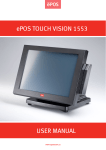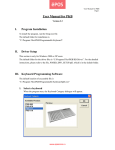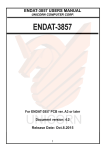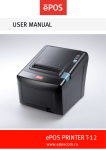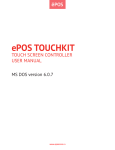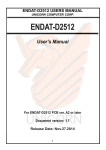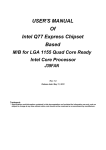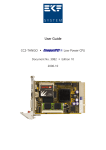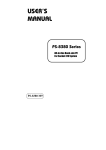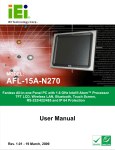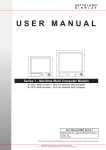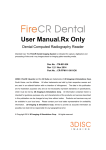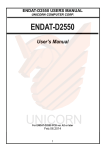Download ATLAS 350
Transcript
ATLAS 350 ALL-IN-ONE ( MONOBLOCK ) USER MANUAL www.eposcom.ru General Information ABOUT THIS MANUAL The purpose of this user’s manual is to provide general information on ePOS ATLAS-350 Series POS terminal and to show the users how to configure the hardware-related configurations. The information in this manual is subject to change without notice due to rapid improvement on IT technology. The users can get the most up to date information from our web site www.eposcom.ru DISCLAIMER This manual has been examined for accuracy. While precaution has been taken in the preparation of this manual, neither the manufacturer takes no liability for errors or omissions nor assume any responsibility for damage(s) incurred directly or indirectly from errors, omissions, or discrepancies of this manual. IN NO EVENT WILL THE VENDOR BE LIABLE FOR DIRECT, INDIRECT, SPECIAL, INCIDENTAL, OR CONSEQUENTIAL DAMAGES ARISING OUT OF THE USE OR INABILITY TO USE THIS PRODUCT OR DOCUMENTATION, EVEN IF THE POSSIBILITY OF SUCH DAMAGES HAS BEEN ADVISED. IN PARTICULAR, THE VENDOR SHALL NOT HAVE LIABILITY FOR ANY HARDWARE, SOFTWARE, OR DATA STORED OR USED WITH THE PRODUCT, INCLUDING THE COSTS OF REPAIRING, REPLACING, OR RECOVERING SUCH HARDWARE, SOFTWARE OR DATA. WARNING The terminal has been tested and found to comply with the limits for a Class A digital device, pursuant to Part 15 of the FCC rules. These limits are designed to provide reasonable protection against harmful interface in a residential installation. This equipment can generate and radiate radio frequency energy and, if not installed and used according to the instructions, may cause harmful interference to radio communications. However, there is no guarantee that interface will not occur under particular installation. If this equipment does cause harmful interference to radio or television reception, which is found by turning the equipment off and on, the user is encouraged to try to correct the interface by one or more of the following measures: Reorient or relocate the receiving antenna Increase the distance between the equipment or device Connect the equipment to an outlet other than the receiver’s Consult a dealer or an experienced radio/TV technician for assistance i www.eposcom.ru CAUTION The system is provided with a battery-powered Real-Time Clock circuit. There is a danger of exposing and personal injury if the battery is incorrectly replaced or mistreated. Do not attempt to disassemble the battery, immerse it in the water or expose it to fire. WARRANTY LIMITS If the ATLAS-350 series machine is disassem bled by any person other than the authorized technicians, the warranty will be terminated. The users should consult his/her dealer for any technical problems. Warranty does not cover any damage caused by improper use. ii www.eposcom.ru IMPORTANT SAFETY INFORMATION z Read following instructions carefully. z Use only parts, especially power adapter, recommended by the manufacturer; unapproved parts may be hazardous. z Before plugging the power cord into the AC inlet of the power supply unit, make sure the voltage (either 110V or 220V) is properly applied to the power switch. Improper voltage will cause damage to the power supply unit. z Power off the system and remove the power adapter while cleaning the system. z Before powering on the system, make sure all the peripherals are firmly installed. z Do not use the system near water, such as a bathtub, a washbowl, a kitchen sink, a laundry tub, and a swimming pool. Do not expose the machine under direct sunlight, and keep it away from any heat source. z Do not place the system on an unstable cart, stand or table. If the machine falls, it may injure a person or cause serious damage to the appliance. z The system is equipped with a three-wire grounded plug with a third (grounding) pin. This is a safety feature. If your outlet does not accommodate the three-wire plug, have an electrician install a correct outlet, or use an adapter to ground the appliance safely. Do not leave out the safety purpose of the grounded plug. z Do not allow anything to rest on the power cord. Do not locate the system where people may walk on the cord. z Do not make the power outlet and extension cords overload. Overload can result in fire or electric shock. z Do not push any object into the computer cabinet. Dangerous voltage points may be touched and the parts may be shorted out resulting in fire or electric shock. z Do not attempt to service the system on your own. Opening or removing cover can expose you to dangerous voltage or other hazards. z Power off the system before installing or removing non-PNP (plug and play) devices. z If any of the following situations occurs, unplug the systems from the power outlet immediately and consult with a qualified service person: 1. The power cord or plug is damaged or frayed. 2. Liquid is spilled into the system. 3. The system is dropped or the cabinet is damaged. z When the system is not in use, cover the system and store it with care. iii www.eposcom.ru Contents ABOUT THIS MANUAL ....................................................................................................... i DISCLAIMER......................................................................................................................... i WARNING .............................................................................................................................. i CAUTION .............................................................................................................................. ii WARRANTY LIMITS ........................................................................................................... ii TRADE MARKS AND SERVICE MARKS ......................................................................... ii IMPORTANT SAFETY INFORMATION ............................................................................ iii 1. Introduction ......................................................................................................... 2 1.1 Unpacking......................................................................................................................... 2 1.2 System Overview.............................................................................................................. 4 1.3 I/O Ports............................................................................................................................ 7 1.4 Specifications.................................................................................................................... 9 2. Components & Peripherals Installation ......................................................... 11 2.1 Replace Hard Disk...........................................................................................................11 2.2 Install Rear Top Mount Customer Display (Cutebase only) .......................................... 13 2.3 Install Second Display (Standard-base only).................................................................. 14 2.4 Install Pole-type Customer Display (Standard-base only) ............................................. 15 3. BIOS Setup Information................................................................................... 16 Entering Setup ...................................................................................................................... 18 Main Menu ........................................................................................................................... 19 Standard CMOS Setup Menu ............................................................................................... 21 Advanced BIOS Features ..................................................................................................... 23 Advanced Chipset Features .................................................................................................. 26 Integrated Peripherals ........................................................................................................... 29 Power Management Setup .................................................................................................... 36 PnP/PCI Configurations ....................................................................................................... 38 PC Health Status................................................................................................................... 39 Frequency/Voltage Control................................................................................................... 41 4. Drivers Installation ........................................................................................... 42 4.1 Install Chipset driver ...................................................................................................... 42 4.2 Install Graphic ................................................................................................................ 45 4.3 Install Audio Driver ........................................................................................................ 49 4.4 Install LAN Driver.......................................................................................................... 50 4.5 Install Wi-Fi.................................................................................................................... 52 5. Peripherals Testing............................................................................................ 61 5.1 Magnetic Stripe Card Reader ......................................................................................... 61 5.2 Customer Display ........................................................................................................... 62 www.eposcom.ru 5.3 Second Display ............................................................................................................... 63 5.4 Cash Drawer ................................................................................................................... 65 6. Jumper Settings & Connectors ........................................................................ 68 6.1 The Main Board Jumper Location.................................................................................. 68 6.2 Jumper Settings .............................................................................................................. 69 6.3 Connectors ...................................................................................................................... 72 6.4 Internal pin define........................................................................................................... 73 www.eposcom.ru 1. Introduction 1.1 Unpacking The contents may vary with different options. If there’s any physical damage or missing parts, please contact your supplier immediately. Please keep all packing materials in case you need to ship back the device for service. Unpacking ATLAS-350 The ATLAS-350 and accessories are packed in a paperboard carton. And it is wrapped by foam padding for protection during shipping. 2 www.eposcom.ru ATLAS-350 ATLAS-350 ATLAS-350 main system HDD ( 2.5” SATA ) / Compa ct F lash (Option) / Dis k on Module (Option) SODIMM DDR2 (1 ~ 4GB) CPU : Intel Core Duo T2500 2GHz or Core 2 Duo T7400 2.16GHz Power adapter (Hidden on Base) AC power cord Driver CD Magnetic stripe card reader (Option) Customer display (Option) WiFi module (Option) 3 www.eposcom.ru 1.2 System Overview Front View Rear View www.eposcom.ru z Bottom View z Side View www.eposcom.ru Options: Cutebase Standard www.eposcom.ru 1.3 I/O Ports Port Description USB Connect devices with USB connectors. There are 4 external USB ports reserved and two additional left side ports. Mouse PS/2 Mouse Connector KB PS/2 Keyboard Connector PWR IN A 4 din rounded-power-jack for connecting an AC to DC +12V power adapter. PWR COM COM 1/2 support power RI/5/12V ,refer to the PWR COM Jumper Setting figure in page 8. Extend KB 8-pin pitch 2.0 for keyboard. AUDIO OUT Earphone or speaker connector with 2 internal speakers. DC12V OUT 12VDC jack for customer display (VFD). Serial 3 x COM with Power Selected 5/12V on pin9 1 x COM for Touch Option, 1 x COM Reserved 4 x DB9 RS-232. COM 1/2/4: pin 9 RI/5V/12V selected by jumper. CASH DRAWER RJ11 connector with selected 12/24V LAN RJ-45 connector with link/ack integrates speed LED and supports wake-from-LAN function. CF A slot for inserting CF card VGA A 15 pin D-type connector serves to transmit VGA data to the monitor. www.eposcom.ru PWR COM Jumper Setting COM 1 2 Voltage Voltage RI(Defult) 5V 12V www.eposcom.ru Cash Drawer pin5-6 Pin11-12 pin3-4 pin9-10 pin1-2 pin7-8 12V Pin13-14 24V Pin15-16 1.4 Specifications ATLAS-350 Model Main Board CPU Support Intel Celeron M 440 (1.86GHz , 1M Cache, 533M FSB) Intel Core Duo T2500 (2GHz , 2M Cache , 667M FSB) Intel Core 2 Duo T7400 (2.16GHz , 4M Cache, 667M FSB) Chipset Intel 82945GME + 82801GBM(ICH7) System Memory 2 x 200pin DDR2 533/667MHz SODIMM Socket , up to 4GB Graphic Memory Share System Memory 64~224MB BIOS Award LCD Touch Panel LCD Size 12.1” 15” 17” Brightness 400nits 250nits 300nits Resolution 1024 x 768 1024 x 768 1280 x 1024 Touch Screen 5 wire Resistive or SAW Tile Angle 15~80 Degree Storage HDD 1 x 2.5” SATA HDD Bay Flash Memory 1 x Compact Flash Slot (Type 1 & 2) Internal Expansion USB 2.0 1 x Touch , 1 x WI-FI Serial 1 x COM for Touch Option, 1 x COM Reserved I/O Ports USB 2.0 4 x External I/O, 2 x Left Side I/O Serial 3 x COM with Power Selected 5/12V on pin9 Parallel 1 x DB25 PS2 1 x KB , 1 x MS on Left Side I/O LAN 2 x Giga LAN ( Realtek 8111C) 2nd Display 1 x VGA, DB15 Cash Drawer 1 x RJ11, Selected 12/24V DC In 1 x 4pin 12V , 7.5A DC Out 1 x 12V for Customer or 2nd Display Audio 1 x Line Out, 1 x Mic In, 2 x Internal Speaker 2W Power Power Adapter Hidden on Base, 12V , 90W ,w/ Cable Head Lock Indicator 1 x Power LED in Blue Optional Peripheral 9 www.eposcom.ru MSR 3 Track, PS2 or USB or COM Customer Display VFD / LCD, Rear Mount or Pole Type 2nd Display 12.1”, 15” with or without Touch Environment EMC & Safety FCC & CE Operating Temp. 0 ~ 40℃ Storage Temp. -20 ~ 55℃ Operating Humidity 20% ~ 80% RH non-condensing Storage Humidity 20% ~ 85% RH non-condensing Dimension(WxDxH) 310x260x290mm 369x260x340mm 396x260x377mm Weight (Kgs) 5.7 6.3 7.3 OS Support POS Ready, XP Pro, Vista, Linux 10 www.eposcom.ru 2. Components & Peripherals Installation 2.1 Replace Hard Disk a. Lift the cover from the upper side edges as marked by the circles and push it down to remove it. b. Lossen the screw x 4 on the VESA bracket. c. Turn over the system to loosen the screw x 2 on the back of the panel. www.eposcom.ru d. Remove the panel from the VESA bracket. e. Loosen the screw on the cover of the hard disk bay to remove the cover. f. Loosen the spacer. www.eposcom.ru g. Hold the hard disk and take it out in the direction. Then unplug it from the connector. h. Loosen the 4 screws to remove the hard disk from the bracket. Then install the new hard disk following the above steps with the order reversed. 2.2 Install Rear Top Mount Customer Display (Cutebase only) a. Pass cord of the rear top mount display through the holes in the direction af arrows carefully. Plug the cable to a free COM port and connect the extension power cable. www.eposcom.ru b. Press the stand of the customer display into place. 2.3 Install Second Display (Standard-base only) Hold the second display and turn the system over carefully. Pass the cord through the holes in the directions of the arrows. Plug the cable into the VGA port and connect the extension power cable. Tighten the bundled screws specified for the stand of the second display to fix it to place. www.eposcom.ru 2.4 Install Pole-type Customer Display (Standard-base only) a. Pass the cord of the customer display through the holes in the directions of the arrows. Plug the cable to a free COM port and connect the extension power cable. b. Press the stand of the customer display into place. c. Tighten the bundled screws specified for the stand of the second display to fix it to place. Note z For the Cutebase type, there is no Second Disply/Pole-type Display option. z The rear top mount customer display has been pre-installed in factory. www.eposcom.ru 3. BIOS Setup Information The ATLAS-350 main board is compatible with Windows 95/98/2000/XP and Red Hat Linux 9.0. If the drivers are required, find the necessary files in the support CD. The storage media can be HDD, Compact Flash (CF), or Disk on Module (DOM) depending on different options. a. Plug the AC power cord of the power adapter to the PWR IN port. Connect an external CD-ROM to the POS system as the figure shown below and insert the installation CD for the Operating System. b. Turn on the system, press DEL to enter the BIOS main menu, select “Advanced BIOS Features” and click Enter. c. Phoenix- AwardBIOS CMOS Setup Utility Standard CMOS Features Advanced BIOS Features Advanced Chipset Features Integrated Peripherals Power Management Setup PnP/PCI Configurations Frequency/Voltage Control Load Fail-Safe Defaults Load Optimized Defaults Set Supervisor Password Set User Password Save & Exit Setup Exit Without Saving PC Health Status ESC : Quit F10 : Save & Exit Setup ↑ ↓ → ← : Select Item Time, Date, Hard Disk Type … 16 www.eposcom.ru d. Select “USB-CDROM” at Fitst Boot Device. Press F10 to save and exit setup, then restart the system. It will enter the “Setup from CD-ROM” mode. Insert the setup CD to start the Operation System installation. Phoenix- AwardBIOS CMOS Setup Utility Advanced BIOS Features ►CPU Feature ►Hard Disk Boot Priority Virus Warning CPU L1 & L2 Cache CPU L3 Cache Hyper-Threading Technology Quick Power On Self Test First Boot Device Second Boot Device Third Boot Device Boot Other Device Boot Up NumLock Status Gate A20 Option Typematic Rate Setting x Typematic Rate (Chars/Sec) x Typematic Delay (Msec) Security Option MPS Version Control For OS OS Select For DRAM > 64M Report No FDD For WIN 95 Small Logo(EPA) Show ↑↓→←: Move Enter: Select F5: Previous Values [Press Enter] [Press Enter] [Disabled] [Enabled] [Enabled] [Enabled] [Enabled] [USB-CDROM] [Hard Disk] [USB-FDD] [Enabled] [On] [Fast] [Disabled] 6 250 [Setup] [1.4] [Non-OS2] [No] [Disabled] +/-/PU/PD: Value F10: Save F6: Fail-Safe Defaults Item Help Menu Level ESC: Exit f F1: General Help F7: Optimized Defaults AEB-945GME0 is equipped with the AWARD BIOS stored in SPI Flash ROM. These BIOS has a built-in Setup program that allows users to modify the basic system configuration easily. This type of information is stored in CMOS RAM so that it is retained during power-off periods. When system is turned on, AEB-945GME0 communicates with peripheral devices and checks its hardware resources against the configuration information stored in the CMOS memory. If any error is detected, or the CMOS parameters need to be initially defined, the diagnostic program will prompt the user to enter the SETUP program. Some errors are significant enough to www.eposcom.ru abort the start-up. Entering Setup Turn on or reboot the computer. When the message “Hit <DEL> if you want to run SETUP” appears, press <Del> key immediately to enter BIOS setup program. If the message disappears before you respond, but you still wish to enter Setup, please restart the system to try button. “COLD START” again by turning it OFF and then ON, or touch the "RESET" You may also restart from “WARM START” by pressing keys simultaneously. <Ctrl>, <Alt>, and <Delete> If you do not press the keys at the right time and the system will not boot, an error message will be displayed and you will again be asked to, Press <F1> to Run SETUP or Resume In HIFLEX BIOS setup, you can use the keyboard to choose among options or modify the system parameters to match the options with your system. keystroke functions in BIOS setup. General Help ↑↓→ ← : Move Enter : Select + / - /PU /PD : Value ESC : Exit F1 : General Help F2 : Item Help F5 : Previous Values F6 : Fail-Safe Defaults F7 : Optimized Defaults F9 : Menu in BIOS F10 : Save www.eposcom.ru The table below will show you all of Main Menu If you enter AEB-945GME0 AWARD BIOS CMOS Setup Utility, you should start with the Main Menu. The Main Menu allows you to select from fourteen setup functions and two exit choices. Use arrow keys to switch among items and press <Enter> key to accept or bring up the sub-menu. Phoenix- AwardBIOS CMOS Setup Utility f Standard CMOS Features f Advanced BIOS Features f Advanced Chipset Features f Integrated Peripherals f Power Management Setup f PnP/PCI Configurations fFrequency/Voltage Control Load Fail-Safe Defaults Load Optimized Defaults Set Supervisor Password Set User Password Save & Exit Setup Exit Without Saving f PC Health Status ↑ ↓ → ← : Select Item ESC : Quit F10 : Save & Exit Setup Time, Date, Hard Disk Type … Note: It is strongly recommended to reload Optimal Setting if CMOS is lost or BIOS is updated. ▲Standard CMOS Features This setup includes SBC parameter as Time , Date , Hard Disk Type …… ▲Advanced BIOS Features For choice special enhance feature . ▲Advanced Chipset Features This setup include display and onboard device setup. ▲ Integrated Peripherals This setup include on board peripheral setup. www.eposcom.ru ▲Power Management Setup This setup can be set SBC power management. ▲PnP/PCI Configurations This setup can be set PCI configuration & resource. ▲PC Health Status This setup can display SBC health state as voltage , board temperature … etc. ▲Frequency/Voltage Control This setup can control CPU clock and frequency ratio. ▲Load Fail-Safe Defaults This setup contain BIOS all item default setup in safe mode. ▲Load Optimized Default This setup contain BIOS all item default setup in best performance mode. ▲Set Supervisor Password Set password to allow access into the BIOS setup for supervisor. ▲Set User Password This setup can set password to allow access into the BIOS limit setup. ▲Save & Exit Setup Save BIOS setup value to CMOS and exit setup. ▲Exit Without Saving Exit setup and keep last time setup value. www.eposcom.ru Standard CMOS Setup Menu This setup page includes all the items in a standard compatible BIOS. Use the arrow keys to highlight the item and then use the <PgUp>/<PgDn> or <+>/<-> keys to select the value or number you want in each item and press <Enter> key to certify it. Follow command keys in CMOS Setup table to change Date, Time, and IDE item. Phoenix- AwardBIOS CMOS Setup Utility Standard CMOS Features Date (mm:dd:yy) Time (hh:mm:ss) Item Help Thu, Jul 6 2007 21 : 29 : 50 Menu Level f IDE Primary 0 Master f IDE Primary 0 Slave f IDE Secondary 1 Master f IDE Secondary 1 Slave [HDS728080PLAT20] [None] [None] [None] Video Halt On [EVG/VGA] [All, But Keyboard] Base Memory Extended Memory Total Memory 640K 1038336K 1038336K ↑↓→←: Move Enter: Select F5: Previous Values +/-/PU/PD: Value F10: Save F6: Fail-Safe Defaults ▲Date The data format : [week],[month],[day],[year]. ▲Time The time format : [hour],[minute],[second]. ▲IDE Primary 0 Master Auto detect IDE device on channel 0, Press “Enter” for automatic device detection. www.eposcom.ru f Change the day, month, year and century ESC: Exit F1: General Help F7: Optimized Defaults ▲IDE Primary 0 Slave Auto detect IDE device on channel 0, Press “Enter” for automatic device detection. ▲IDE Primary 1 Master Auto detect IDE device on channel 1, Press “Enter” for automatic device detection. ▲IDE Primary 1 Master Auto detect IDE device on channel 1, Press “Enter” for automatic device detection. ▲Video Select the type of primary video subsystem in your computer. The BIOS usually detects the correct video type automatically. EGA/VGA Enhance Graphics Adapter/Video Graphics Array. For EGA, VGA, SEGA, SVGA or PGA monitor adapters. CGA40 Color Graphics Adapter, power up in 40 column mode. CGA80 Color Graphics Adapter, power up in 80 column mode. MONO Monochrome adapter, includes high resolution monochrome adapters. ▲Halt On During the power-on self-test(POST), the computer stops if the BIOS detects a hardware error. You can tell the BIOS to ignore certain errors during POST and continue the boot-up process. These are the selections: No errors All errors All, But keyboard POST does not stop for any errors. If the BIOS detects any non-fatal error, POST stops and prompts you to take corrective action. POST does not stop for a keyboard error, but stops for all other errors. ▲Base Memory Typically 640 KB. Also called conventional memory. The DOS operating system and conventional applications use this area. ▲Extended Memory Above the 1-MB boundary. Early IBM personal computers could not use memory above 1MB, but current PCs and their software can use extended memory. www.eposcom.ru ▲Total Memory Total system memory available area. Advanced BIOS Features This section allows you to configure your system for basic operation. You have the opportunity to select the system’s default speed, boot-up sequence, keyboard operation, shadowing and security. Phoenix- AwardBIOS CMOS Setup Utility Advanced BIOS Features ►CPU Feature ►Hard Disk Boot Priority Virus Warning CPU L1 & L2 Cache CPU L3 Cache Hyper-Threading Technology Quick Power On Self Test First Boot Device Second Boot Device Third Boot Device Boot Other Device Boot Up NumLock Status Gate A20 Option Typematic Rate Setting x Typematic Rate (Chars/Sec) x Typematic Delay (Msec) Security Option MPS Version Control For OS OS Select For DRAM > 64M Report No FDD For WIN 95 Small Logo(EPA) Show ↑↓→←: Move Enter: Select F5: Previous Values [Press Enter] [Press Enter] [Disabled] [Enabled] [Enabled] [Enabled] [Enabled] [USB-CDROM] [Hard Disk] [USB-FDD] [Enabled] [On] [Fast] [Disabled] 6 250 [Setup] [1.4] [Non-OS2] [No] [Disabled] +/-/PU/PD: Value F10: Save F6: Fail-Safe Defaults www.eposcom.ru Item Help Menu Level ESC: Exit f F1: General Help F7: Optimized Defaults ▲CPU Feature Display CPU parameter information. ▲Hard Disk Boot Priority Select boot sequence for HDD type device. ▲CPU L1 & L2 Cache CPU L1 & L2 function Enabled/Disabled. ▲CPU L3 Cache CPU L3 function Enabled/Disabled. ▲First Boot Device Select boot device1. Ex : HDD , CDROM …. ▲Second Boot Device2 Select boot device. Ex : HDD , CDROM … ▲Third Boot Device Select boot device3. Ex : HDD , CDROM … Note : If boot device 1-3 setup as CD-ROM,HDD,USBFDD , System will follow setup to boot system. ▲Gate A20 Option Fast-lets chipsets control Gate A20 and Normal – a pin in the keyboard controller controls Gate A20. Default is Fast. The choice: Normal, Fast. ▲Typematic Rate Setting Keystrokes repeat at a rate determined by the keyboard controller – When enabled, the typematic rate and typematic delay can be select. The choice: Enabled, Disabled. ▲Typematic Rate (Chars/sec) The rate at which character repeats when you hold down a key. The choice: 6, 8, 10, 12, 15, 20, 24, and 30. www.eposcom.ru ▲Typematic delay (Msec) The delay before key strokes begin to repeat. The choice: 250, 500, 750, and 1000. ▲Security Option You can setup Setup/System when setup password. Setup : In boot picture will show “Enter Password” message. System : Into BIOS setup figure will show “Enter Password” message. ▲MPS Version Control For OS The choice: 1.1, 1.4. ▲Report No FDD For WIN 95 The choice: No, Yes ▲OS Select For DRAM > 64M Select OS/2 only if you are running OS/2 operating system with greater than 64MB of RAM on the system. The choice: Non-OS2, OS2. ▲Small Logo(EPA) Show Enabled/Disabled Small Logo. www.eposcom.ru Advanced Chipset Features This section allows you to configure the system based on the specific features of the Intel 945GME Chipset. This Chipset manages bus speeds and access to system memory resources.VGA display port and onboard device control. It also coordinates communications between the conventional ISA bus and the PCI bus. never need to be altered. It must be stated that these items should The default settings have been chosen because they provide the best operating conditions for your system. The only time you might consider making any changes would be if you discovered that data was being lost while using your system. Phoenix- AwardBIOS CMOS Setup Utility Advanced Chipset Features Item Help DRAM Timing Selectable [By SPD] x CAS Latency Time Auto x DRAM RAS# to CAS# Delay Auto x DRAM RAS# Precharge Auto x Precharge delay (tRAS) Auto x System Memory Frequency Auto SLP_S4# Assertion Width [1 to 2 sec. ] System BIOS Cacheable [Enabled] Video BIOS Cacheable [Disabled] Memory Hole At 15M-16M [Disabled] ►PCI Express Root Port Function[Press Enter] ** VGA Setting ** PEG/Onchip VGA Control On-Chip Frame Buffer Size DVMT Mode DVMT/FIXED Memory Size Boot Display Panel Type by Hardware x Panel Number Onboard LAN1 Onboard LAN2 ↑↓→←: Move Enter: Select F5: Previous Values [Auto] [8MB] [DVMT] [128 MB] [Auto] [Enabled] 1024x768 [Enabled] [Enabled] +/-/PU/PD: Value Menu Level f 24Bit F10: Save F6: Fail-Safe Defaults www.eposcom.ru ESC: Exit F1: General Help F7: Optimized Defaults ▲CAS Latency Time This option controls the number of SCLKs between the time a read command is sampled by the SDRAMs and the time the GMCH samples correspondent data from the SDRAMs. Default : Auto. ▲Active to Precharge Delay This is to DDR standard accordingly Default : Auto. ▲DRAM RAS# to CAS# Delay This option controls the number of SCLKs (SDRAM Clock) from a row activate command to a read or write command. If your system installs good quality of SDRAM, Normally, the option will be set to Auto. ▲DRAM RAS# Precharge This option controls the number of SCLKs for RAS# precharge. If your system installs good quality of SDRAM, It is set to auto normally. ▲System Memory Frequency This option controls the number of System Memory Frequency. It is set to auto normally. ▲SLP_S4# Assertion Width This option controls SLP_S4# Assertion Width Default : [1 to 2 sec. ] ▲System BIOS Cacheable Selecting Enabled allows caching of the system BIOS ROM at F0000h-FFFFFh, resulting in better system performance. However, if any program writes to this memory area, a system error may result. ▲System BIOS Cacheable Select “Enabled” to enable caching VGA BIOS into L2 cache to get higher display performance. “Disabled” to ignore this BIOS caching function. ▲Memory Hole At 15M-16M This setting allows users to enable or disable the 1MB of memory required by some ISA expansion cards. www.eposcom.ru ▲PCI Express Root Port Function This setting allows users to setup for some PCI Express chip function. ** VGA Setting ** ▲PEG/Onchip VGA Control Setup Onchip VGA Control. Default : Auto. ▲On-Chip Frame Buffer Size Setup On-Chip Frame Buffer Size: 8MB. ▲DVMT Mode DVMT Mode select : Enabled DVMT. ▲DVMT/FIXED Memory Size Setup DVMT/FIXED Memory Siz: 128MB. ▲Boot Display To setup boot display port as [Auto] , [CRT] , [LFP] ,[CRT+LFP]. ▲Panel Type by Hardware [Enabled] Select Panel type by onboard jump : JLCD_SEL Please refer hardware jump setting. [Disabled] Depend on BIOS setup for panel resolution. ▲Panel Number These fields allow you to select the LCD Panel type. The default values for these ports are : 800x600 18Bit 1024x768 18Bit 1024x768 24Bit 1280x1024 24Bit ▲On chip LAN1 Enabled or Disable LAN1 function. www.eposcom.ru ▲On chip LAN2 Enabled or Disable LAN2 function. Integrated Peripherals Phoenix- AwardBIOS CMOS Setup Utility Integrated Peripherals f OnChip IDE Device f Onboard Device f Super IO Device Onboard Lan Boot ROM Watch Dog Timer Select Onboard Serial Port 3 Serial Port 3 Use IRQ Onboard Serial Port 4 Serial Port 4 Use IRQ Onboard Serial Port 5 Serial Port 5 Use IRQ Onboard Serial Port 6 Serial Port 6 Use IRQ f USB Device Setting ↑↓→←: Move Enter: Select F5: Previous Values [Press Enter] [Press Enter] [Press Enter] [Disabled] [Disabled] [3E8] [IRQ10] [2E8] [IRQ11] [4F8] [IRQ5] [4E8] [IRQ11] [Press Enter] +/-/PU/PD: Value F10: Save F6: Fail-Safe Defaults ▲OnChip IDE Device Display IDE device mode setting. ▲Onboard Device Display On board device content. ▲Super IO Device Display Super IO device item. ▲Onboard Serial Port 3 Serial IO Port 3 address value [3E8]. www.eposcom.ru Item Help Menu Level ESC: Exit f F1: General Help F7: Optimized Defaults ▲Serial Port 3 Use IRQ Serial IO Port 3 IRQ value [10]. ▲Onboard Serial Port 4 Serial IO Port 4 address value [2E8]. ▲Serial Port 4 Use IRQ Serial IO Port 4 IRQ value [11]. ▲Onboard Serial Port 5 Serial IO Port 5 address value [4F8]. ▲Serial Port 5 Use IRQ Serial IO Port 5 IRQ value [5]. ▲Onboard Serial Port 6 Serial IO Port 6 address value [4E8]. ▲Serial Port 6 Use IRQ Serial IO Port 6 IRQ value [11]. ▲USB Device Setting Display USB device advance item. www.eposcom.ru Phoenix- AwardBIOS CMOS Setup Utility OnChip IDE Device IDE HDD Block Mode IDE DMA transfer access On-Chip Primary PCI IDE IDE Primary Master PIO IDE Primary Slave PIO IDE Primary Master UDMA IDE Primary Slave UDMA On-Chip Secondary PCI IDE IDE Secondary Master PIO IDE Secondary Slave PIO IDE Secondary Master UDMA IDE Secondary Slave UDMA Item Help [Enabled] [Enabled] [Enabled] [Auto] [Auto] [Auto] [Auto] [Enabled] [Auto] [Auto] [Auto] [Auto] Menu Level f If your IDE hard drive Supports block mode Select Enabled for Automatic detection of The optimal number of block read/writes per sector the drive can support ** On-Chip Serial ATA Setting ** On chip Serial ATA [Auto] X SATA PORT Speed Settings Disabled X PATA IDE Mode Primary SATA Port P1,P3 is secondary ↑↓→←: Move Enter: Select +/-/PU/PD: Value F5: Previous Values F10: Save F6: Fail-Safe Defaults ESC: Exit F1: General Help F7: Optimized Defaults ▲IDE HDD Block Mode Block mode is also called block transfer, multiple commands, or multiple sector read/write. ▲IDE DMA transfer access UDMA (Ultra DMA) is a DMA data transfer protocol that utilizes ATA commands and the ATA bus to allow DMA commands to transfer data at a maximum burst rate of 33 MB/s. ▲On-Chip Primary PCI IDE ▲On-Chip Secondary PCI IDE The chipset contains a PCI IDE interface with support for two IDE channels. Select Enabled to activate the IDE interface. Select Disabled to deactivate this interface, if you install a primary and/or secondary add-in IDE interface. www.eposcom.ru ▲IDE Primary Master PIO ▲IDE Primary Slave PIO ▲Secondary Master PIO ▲Secondary Slave PIO The four IDE PIO (Programmed Input/Output) fields let you set a PIOmode (0-4) for each of the four IDE devices that the onboard IDE interface supports. Modes 0 through 4 provide successively increased performance. In Auto mode, the system automatically determines the best mode for each device. ▲IDE Primary Master UDMA ▲IDE Primary Slave UDMA ▲IDE Secondary Master UDMA ▲IDE Secondary Slave UDMA UDMA (Ultra DMA) is a DMA data transfer protocol that utilizes ATA commands and the ATA bus to allow DMA commands to transfer data at a maximum burst rate of 33 MB/s. When you select Auto in the four IDE UDMA fields (for each of up to four IDE devices that the internal PCI IDE interface supports), the system automatically determines the optimal data transfer rate for each IDE device. ▲On-Chip Serial ATA Setting The fields under the SATA setting include On-chip Serial ATA(Auto), PATA IDE Mode(Primary) and SATA Port(P1,P3 is Secondary). AHCI function is setup at Enhance mode. www.eposcom.ru Phoenix- AwardBIOS CMOS Setup Utility Onboard Device Azalia/AC97 Audio Select ↑↓→←: Move Enter: Select F5: Previous Values [Auto] +/-/PU/PD: Value Menu Level F10: Save F6: Fail-Safe Defaults ESC: Exit f F1: General Help F7: Optimized Defaults ▲Azalia/AC97 Audio Select Onboard Audio chip Auto/disabled select. Phoenix- AwardBIOS CMOS Setup Utility Super IO Device Onboard Serial Port 1 Onboard Serial Port 2 UART Mode Select X RxD, TxD Active X IR Transmission Delay X UR2 Duplex Mode X Use IR Pins Onboard Parallel Port Parallel Port Mode X EPP Mode Select X ECP Mode Use DMA PWRON After PWR-Fail ↑↓→←: Move Enter: Select F5: Previous Values [3F8/IRQ4] [2F8/IRQ3] [Normal] Hi, Lo Enabled Half IR-Rx2Tx2 [378/IRQ7] [SPP] EPP1.7 3 [Off] +/-/PU/PD: Value Menu Level F10: Save F6: Fail-Safe Defaults www.eposcom.ru ESC: Exit f F1: General Help F7: Optimized Defaults ▲Onboard Serial Port 1 Serial IO Port 1 address/IRQ value [3F8/IRQ4]. ▲Onboard Serial Port 2 Serial IO Port 2 address/IRQ value [2F8/IRQ3]. ▲Onboard Parallel Port Parallel Port address/IRQ value [378/IRQ7]. ▲UART Mode select This field determines the UART mode in your computer. The default value is Normal. Other options include ASKIR and IrDA. ▲Parallel Port Mode Select an operating mode for the onboard parallel (printer) port. Select Normal, Compatible, or SPP unless you are certain your hardware and software both support one of the other available modes. ▲PWRON After PWR-Fail This item allows user to configure the power status of using ATX power supply after a serious power loss occurs. On System automatically restores power back Off System stays at power –off www.eposcom.ru Phoenix- AwardBIOS CMOS Setup Utility USB Device Setting USB 1.0 Controller USB 2.0 Controller USB Operation Mode USB Keyboard Function USB Mouse Function USB Storage Function [Enabled] [Enabled] [High Speed] [Enabled] [Enabled] [Enabled] Menu Level [Enabled] or [Disabled] Universal Host Controller Interface for Universal Serial Bus. *** USB Mass Storage Device Boot Setting *** GENERIC USB Disk 2.0 U204 [Auto mode] ↑↓→←: Move Enter: Select F5: Previous Values +/-/PU/PD: Value F10: Save F6: Fail-Safe Defaults ESC: Exit F1: General Help F7: Optimized Defaults ▲USB 1.0 Controller This setting is used to enable/disable the USB 1.0 Controller. ▲USB 2.0 Controller This setting is used to enable/disable the USB 2.0 Controller. ▲USB Operation Mode This setting is used USB device operation in high or low speed. ▲USB Keyboard Function This setting is used to enable/disable the USB Keyboard Function. ▲USB Mouse Function This setting is used to enable/disable the USB Mouse Function. ▲USB Storage Function This setting is used to enable/disable the USB Storage Function. www.eposcom.ru f Power Management Setup The Power Management Setup allows you to configure you system to most effectively save energy while operating in a manner consistent with your own style of computer use. Phoenix- AwardBIOS CMOS Setup Utility Power Management Setup f PCI Express PM Function ACPI Function ACPI Suspend Type x Run VGABIOS if S3 Resume Soft-Off by PWR-BTTN Power On by Ring Resume by Alarm X Date(of Month) Alarm X Time(hh:mm:ss) Alarm ↑↓→←: Move Enter: Select F5: Previous Values [Press Enter] [Enabled] [S1(POS)] Auto [Instant-Off] [Disabled] [Disabled] 0 0 : 0 :0 +/-/PU/PD: Value F10: Save F6: Fail-Safe Defaults Item Help Menu Level ESC: Exit f F1: General Help F7: Optimized Defaults ▲PCI Express PM Function The field is for onboard PCI Express device PM function. ▲ACPI Function This item allows you to enable/disable the Advanced Configuration and Power Management (ACPI). ▲ACPI Suspend Type The default setting of the ACPI mode is S1(POS). ▲Soft-Off by PWR-BTTN This field defines the power-off mode when using an ATX power supply. The “Instant –off” mode allows powering off immediately upon pressing the power button. In the “Delay 4 sec” mode. The system power off when the power button is pressed for more than four seconds or enters the suspend mode when press for less than 4 seconds. www.eposcom.ru ▲Power On by Ring When select “Enabled”, a system that is at soft-off mode will be alert to Wake-On-Modem. ▲Resume by Alarm This field enables or disables the resumption of the system operation. When enabled, the user is allowed to set the Date and Time. Phoenix- AwardBIOS CMOS Setup Utility PCI Express PM Function Wake-up by LAN [Disabled] Menu Level f [Enabled] or [Disabled] Universal Host Controller Interface for Universal Serial Bus. ↑↓→←: Move Enter: Select F5: Previous Values +/-/PU/PD: Value F10: Save F6: Fail-Safe Defaults ▲Wake-up by LAN This field allow Enabled or Disabled WOL function. www.eposcom.ru ESC: Exit F1: General Help F7: Optimized Defaults PnP/PCI Configurations This section describes configuring the PCI bus system. PCI, or Personal Computer Interconnect, is a system that allows I/O devices to operate at speeds nearing the speed the CPU itself uses when communicating with its own special components. This section covers some very technical items and it is strongly recommended that only experienced users should make any changes to the default settings. Phoenix- AwardBIOS CMOS Setup Utility PnP/PCI Configurations Reset Configuration Data Resources Controlled By X IRQ Resources PCI/VGA Palette Snoop [Disabled] Item Help [Auto(ESCD)] Press Enter Menu Level f [Disabled] ** PCI Express relative items ** Maximum Payload Size [128] ↑↓→←: Move Enter: Select F5: Previous Values +/-/PU/PD: Value F10: Save F6: Fail-Safe Defaults ESC: Exit F1: General Help F7: Optimized Defaults ▲Reset Configuration Data Default is disabled. Select Enabled to reset Extended System Configuration Data (ESCD) when you exit Setup if you have installed a new add-on and the system reconfiguration has caused such a serious conflict that the OS cannot boot. ▲Resources Controlled By BIOS can automatically configure all the boot and plug and play compatible devices. If you choose Auto, you cannot select IRQ DMA and memory base address fields, since BIOS automatically assigns them. ▲PCI/VGA Palette Snoop Some non-standard VGA display cards may not show colors properly. www.eposcom.ru This field allows you to set whether or not MPEG ISA/VESA VGA cards can work with PCI/VGA. When this field is enabled, a PCI/VGA can work with a MPEG ISA/VESA VGA card. When this field is disabled, a PCI/VGA can not work with an MPEG/VESA card. ▲Maximum Payload Size The default setting of the PCI Express Maximum Payload Size is 128. PC Health Status Phoenix- AwardBIOS CMOS Setup Utility PC Health Status Shutdown Temperature CPU Warning Temperature Current System Temperature Current CPU Temperature CPU Fan Speed System Fan Speed Vcore +12 V +1.5 V +1.8 V +5 V +3.3 V VBAT(V) +3.3 VSB (V) [Disabled] [Disabled] 48℃/118℉ 64℃/147℉ [55℃/131℉] System Smart Fan Temp. Backlight Control [Disabled] [Disabled] Enter: Select F5: Previous Values Menu Level f 6337 RPM 0 RPM 0.94 V 11.93 V 1.51 V 1.82V 4.97 V 3.36 V 3.28 V 3.36 V ** Smart Fan Setting ** CPU Smart Fan Temp. ↑↓→←: Move Item Help +/-/PU/PD: Value F10: Save F6: Fail-Safe Defaults www.eposcom.ru ESC: Exit F1: General Help F7: Optimized Defaults ▲Shutdown Temperature This field allows the user to set the temperature by which the system automatically shuts down once the threshold temperature is reached. This function can help prevent damage to the system that is caused by overheating. ▲CPU Warning Temperature This item allows you to set a temperature above which the system will start the beeping warning. ▲Temperatures / Voltages Hardware monitor PC health state. Include temperatures and voltages. ** Smart Fan Setting ** ▲CPU Smart Fan Temp. This is smart fan control feature of CPU temperature. 4 pin header for select PWM or DC type fan. If temperature over setting range , increase fan speed until temperature down. Then decrease fan speed. ▲System Smart Fan Temp. This is smart fan control feature of System temperature. 3 pin header for select DC type fan. If temperature over setting range , increase fan speed until temperature down. Then decrease fan speed. ▲Backlight Control Backlight Control level ,0~5V DC level for select. Header pin is inverter pin4. Default is disabled. www.eposcom.ru Frequency/Voltage Control Phoenix- AwardBIOS CMOS Setup Utility Frequency/Voltage Control Auto Detect PCI CLK Spread Spectrum [Enabled] [Disabled] Item Help Menu Level ↑↓→←: Move Enter: Select F5: Previous Values +/-/PU/PD: Value F10: Save F6: Fail-Safe Defaults ESC: Exit f F1: General Help F7: Optimized Defaults ▲Auto Detect PCI CLK The “Auto Detect PCI CLK” function is enabled PCICLK for PCI card plug in. If have no PCI card in, PCICLK signal will be cut off. ▲Spread Spectrum The Spread spectrum function reduces the EMI generated by modulating the pulses so that the spikes of the pulses are reduced to flatter curve. Note : You can get more detail information at www.phoenix.com. www.eposcom.ru 4. Drivers Installation 4.1 Install Chipset driver a. Double click the folder “Driver & Utility” b. Double click the folder ““MB” and “INF” www.eposcom.ru c. Double click the folder “infinst_autol”, and then the file “Setup” d. Click “Next” as the window pop up www.eposcom.ru e. Click “Yes” on the License Agreement window to accept the terms f. Click “Next” to continue the setting process g. Click “Next” after the setup process finished www.eposcom.ru h. Select “Yes” and click “Finish”, and then restart the system 4.2 Install Graphic a. Double click the folder “Driver & Utility” b. Double click the folder “MB” “Graphic”and then the file “win2k_xp14324.exe” to start the installation. www.eposcom.ru c. Click “Next” as the window pop up. d. Then the software will start extracting files. Click “Next” when the progress finished. e. Click “Next” to continue the setting www.eposcom.ru f. Click “Yes” on the License Agreement window to accept the terms g. Click “Next” h. Click “Next” to continue www.eposcom.ru i. Click “Finish” and restart the system www.eposcom.ru 4.3 Install Audio Driver a. Double click the folder ”Driver & Utility” “MB” “ “Realtek Audio” and the file “Setup.exe” to start the installation. b. Click “Next” on the Audio Setup window. c. Click “Finish” and restart the system. www.eposcom.ru 4.4 Install LAN Driver a. Double click the folder “MB” “RTL8111CLAN””WINXP_2K” and then the file “Setup.exe” to start the installation. b. Click “Next” on the welcome window. c. Click “Install” to continue the setting process www.eposcom.ru d. Click “Finish” to finish the installation. www.eposcom.ru 4.5 Install Wi-Fi a. Execute All Programs >> Control Panel >> Add Hardware. b. Click “Next” on the welcome window. c. Click “Install from a list or specific location [Advanced]” on the Hardware Update Wizard window. www.eposcom.ru d. Select “Search for the best driver” and tick the boxes below. Click “Next” and select “WINXP” from the “Driver” folder accordingly. e. Click “Next” f. Wait for the installation complete and click “Next” www.eposcom.ru g. Click “Finish” to complete the Found New Hardware Wizard h. Double click the folder “POS-8000””Driver & Utility” “Peripherals” and “WiFi WUG2700_V1.0” i. Click the “Setup.exe” file to start the installation www.eposcom.ru j. Click “Yes” to accept the terms on the agreement license window k. Select the “Wireless Configuration Tool” and click “Next” l. Select “Optimize for WiFi mode and click “Next” www.eposcom.ru m.Select “Yes” and click “Finish” to restart the system and complete the WiFi setting 4.6 Install Touch Screen Driver a. Double click the folder “Touch” and then double click the subfolder according to the touch type and operating system. www.eposcom.ru b. Double click the file “setup” to start the installation. c. Click “Next” on the welcome window. d. Select the destination folder and click “Next”. www.eposcom.ru e. Select the Setup type from “Install RS232 driver” or “multimonitor tool” and click “Next”. f. Click “Install” to start the installation. g. Click “Finish” to exit the setup and restart the system. www.eposcom.ru h. Execute All Programs >> Touch Package >> Touch Tool. Select “General” and then click “9 Pts. Linearity” to start the 9-point-calibration. Or select “Advance” to select “4 Pts. calibration” or “25 Pts. Linearity”. The more points are calibrated, the more accurate the calibration will be. www.eposcom.ru i. Touch the center of the red dot on the screen with a finger till it disappears. The dot will appear 4/9/25 times in turn on the screen. j. After the calibration is done, press the “save” button to save. Note. Refer to the file “Userguide2_8” for more information on the setting of the touch package. www.eposcom.ru 5. Peripherals Testing If the ATLAS-350 is equipped with magnetic stripe card reader,customer display, or second display connected to a cash drawer, follow the steps below to test the function. 5.1 Magnetic Stripe Card Reader a. Open the folder “Peripherals” “MSR” and double click the file “BREAKOUT.EXE”. b. After the testing window pops up, slide a magnetic stripe card and its information will show on the window. 61 www.eposcom.ru 5.2 Customer Display a. Open the folder “Peripherals” “Customer Display” and double click the file “BREAKOUT.” b. Enter any keys on the window and the typed words will appear on the customer display. ePOS Components 62 www.eposcom.ru 5.3 Second Display a. Select “Intel ® Graphics Media Accelerator Driver for mobile” from the toolbar b. Select “Graphic Options” c. Select “Output TO” and tick “Notebook” www.eposcom.ru d. Select “Intel® Dual Display Clone and 2 options will appear e. Select “Note+ Monitor”, and both of the main and the second display will be turned on www.eposcom.ru 5.4 Cash Drawer a. Open the folder “Peripherals” “Cash Drawer” and double click the file “setup.exe” b. Click “OK” on the welcome window. c. Select the destination folder and click the icon to start the installation. www.eposcom.ru d. Select an existed group name or enter a new one. Click “Continue.” e. Click “OK” to finish the installation. f. Execute Start >> All Programs >> Cash Drawer >> CashDrawer to open the program. www.eposcom.ru g. Click “Open Cash Drawer” on the window, and the connected cash drawer will open. Note. The above cash drawer driver is for testing only. If editing AP Open drawer is required, please refer to the following command set. Cash Drawer Controller Register Register Location: I/O port 280h Attribute: Read/Write Size: 8 bit Bit 0~3, 5~7: Reserved Bit 4: Cash Drawer “DIO OUTPUT”, pin output control. = 1: Open the Cash Drawer = 0: Close the Cash Drawer Control Command Example Run “Debug.EXE” under DOS or Windows98 Command Description O 280 10 Openning cash drawer O 280 00 Allow to close cash drawer z Set the I/O address 280 bit 4 = 1 to open the cash drawer by “DIO OUTPUT” pin control. z Set the I/O address 280 bit 4 = 0 to close the cash drawer. www.eposcom.ru 6. Jumper Settings & Connectors 6.1 The Main Board Jumper Location www.eposcom.ru 6.2 Jumper Settings JCMOS:CMOS Clear Pin No. Function 1-2 2-3 Normal Operation (Default) Jumper Clear CMOS Contents 3 2 1 Setting 3 2 1 JCF_SEL:Compact Flash ( Master / Slave ) Select Pin No. Function 1-2 2-3 Master Mode Jumper Slave Mode (Default) 3 2 1 Setting 3 2 1 JCOM5 / JCOM6:COM5 / COM6 (5V/12V/RI) Select Pin No. Function 1-2 3-4 +5V 5-6 Modem Ring In +12V (Default) www.eposcom.ru 1 3 5 2 4 6 1 3 5 2 4 6 1 3 5 2 4 6 Jumper Setting JCOM_SEL:COM1 / COM2 (5V/12V/RI) Select (1/4) Pin No. 5-6, 11-12, 13-14 Function COM1 (Ring In) ,COM2 (Ring In), DIO(+12V) (Default) Jumper Setting 15 1 16 2 JCOM_SEL:COM1 (5V/12V/RI) Select (2/4) Pin No. Function 1-2 3-4 COM1 (+12V) 5-6 COM1 (+5V) Modem Ring In (Default) Jumper Setting 15 1 15 1 15 1 16 2 16 2 16 2 JCOM_SEL:COM2 (5V/12V/RI) Select (3/4) Pin No. Function 7-8 9-10 COM2 (+12V) 11-12 COM2 (+5V) Modem Ring In (Default) Jumper Setting 15 1 15 1 15 1 16 2 16 2 16 2 JCOM_SEL:DIO (12V/24V) Select (4/4) Pin No. Function Jumper Setting 13-14 15-16 DIO (+12V) (Default) DIO (+24V) 15 1 15 1 16 2 16 2 www.eposcom.ru JLCD_SEL:LCD Panel Select (1/2) Pin No. Function 1-2, 3-4 3-4, 7-8 800x600x18bit 1-2, 7-8 1024x768x18bit 1024x768x24bit (Default) Jumper Setting 2 4 6 8 2 4 6 8 2 4 6 8 1 3 5 7 1 3 5 7 1 3 5 7 JLCD_SEL:LCD Panel Select (2/2) Pin No. Function 5-6,7-8 1280x1024x24bit Jumper Setting 2 4 6 8 1 3 5 7 JVLVDS:LCD Power (+3.3V / +5V) Select Pin No. Function 1-2 3-4 LCD Power +3.3V (Default) LCD Power +5V Jumper Setting 1 3 2 4 www.eposcom.ru 1 3 2 4 6.3 Connectors Connector Function AUDIO1 Line-in, Line-out, MIC-InConnector SPKR_OUT 6W amplifier Line-out Connector CPUFAN CPUFAN 4-pin Connector CF Cimpat Flash Connector COM1,COM4 Serial port Connector COM5,COM6 Serial port Connector with Box-header DDR1,DDR2 DDR SO-DIMM IDE IDE Connector(Supply +5V) INV1, INV2 LCD inverter Connector KB PS2 Keyboard MINI DIN Connector LPT Printer Connector LVDS LVDS Connector MSR1, MSR2 MSR Connector PS_ON Power Button PWR DC Jack Power Connector RST System Reset Connector SATA1,SATA2 SATA connector SATA_PWR1, SATA_PWR2 SATA Power Connector SYSFAN System FAN connector USB1,USB2 USB Connector with Pin-header USB_KB USB with PS2 Mouse Pin-header USB1_LAN1, USBx2 and RJ45 Connector USB2_LAN1 VGA USB_KB VGA Connector USBx2 and PS2 KB/MS Connector www.eposcom.ru Note 6.4 Internal pin define COM5, COM6:Serial Port with Pin-header (2.0 mm) Pin No. Signal Pin No. Signal 1 DCD 2 DSR 3 RXD 4 RTS 5 TXD 6 CTS 7 DTR 8 RI/+5V/+12V 9 Ground 10 NC CPUFAN:4Pin FAN Connector Pin No. Signal 1 Ground 2 Fan Power (+12V) 3 Speed Sense 4 Control IDE:HDD IDE Connector with Box-header (2.0mm) Pin No. Signal Pin No. Signal 1 RESET# 2 Ground 3 Data 7 4 Data 8 5 Data 6 6 Data 9 7 Data 5 8 Data 10 9 Data 4 10 Data 11 11 Data 3 12 Data 12 13 Data 2 14 Data 13 15 Data 1 16 Data 14 17 Data 0 18 Data 15 19 Ground 20 NC 21 DMA REQ 22 Ground 23 IOW# 24 Ground 25 IOR# 26 Ground 27 IOCHRDY 28 Pull-down 29 DMA ACK# 30 Ground 31 INT REQ 32 NC 33 SA1 34 P66DETECT 35 SA0 36 SA2 www.eposcom.ru 37 HDC CS1# 38 HDC CS3# 39 HDD Active# 40 Ground 41 +5V 42 +5V 43 Ground 44 NC INV1:Inverter Connector with Box header (2.50 mm) Pin No. Signal 1 +12V 2 Ground 3 Inverter Enable 4 Inverter Brightness Control 5 Ground INV2:Inverter Connector with Box header (1.25 mm) Pin No. Signal 1 +12V 2 +12V 3 Ground 4 Inverter Enable 5 Inverter Brightness Control 6 SW_PWR# LVDS:LVDS Panel Signal with Wafer Connector (1.25 mm) Pin No. Signal Pin No. Signal 1 LVDS Power 2 LVDS Power 3 LVDS Power 4 LVDS Power 5 Ground 6 Ground 7 Ground 8 Ground 9 LA_DATA0P 10 LB_DATA0P 11 LA_DATA0N 12 LB_DATA0N 13 Ground 14 Ground 15 LA_DATA1P 16 LB_DATA1P 17 LA_DATA1N 18 LB_DATA1N 19 Ground 20 Ground 21 LA_DATA2P 22 LB_DATA2P 23 LA_DATA2N 24 LB_DATA2N 25 Ground 26 Ground 27 LA_CLKP 28 LB_CLKP www.eposcom.ru 29 LA_CLKN 30 LB_CLKN 31 Ground 32 Ground 33 LA_DATA3P 34 LB_DATA3P 35 LA_DATA3N 36 LB_DATA3N 37 Ground 38 Ground 39 NC 40 NC Note:LVDS Power = +5V or +3.3V (Default) MSR1:External Keyboard Connector with Pin-header (2.0 mm) Pin No. Signal Pin No. Signal 1 +5V 2 Ground 3 KDAT_CON 4 KCLK_CON 5 KDAT_KBC 6 KCLK_KBC 7 COM3_TX 8 COM3_RX 9 KB_EN 10 Ground MSR2:External Keyboard Connector with Pin-header (2.0 mm) Pin No. Signal Pin No. Signal 1 Ground 2 KDAT_KBC 3 KDAT_CON 4 KCLK_KBC 5 KCLK_CON 6 +5V 7 KB_EN 8 Ground PS_ON:Power Button with Pin-header (2.0 mm) Pin No. Signal 1 SW_PWR# 2 Ground PWR:DC Jack Pin No. Signal 1 Ground 2 Ground 3 +12V 4 +12V www.eposcom.ru PWR_LED:LED Indicator with Pin-header Pin No. Signal 1 Power LED- (Ground) 2 Power LED+ ( +5V, 470 Ohm) 3 HDD LED- 4 HDD LED+ ( +5V, 470 Ohm) RST:System Reset with Pin-header Pin No. Signal 1 Ground 2 Reset SATA_PWR1 / SATA_PWR2:SATA Power Connector with Box-header 2.0 mm) Pin No. Signal 1 +12V 2 Ground 3 Ground 4 +5V SPKR_OUT:Audio Amplifier Output with Pin-header (2.0 mm) Pin No. Signal 1 Amplifier-Out Left 2 Ground 3 Ground 4 Amplifier-Out Right www.eposcom.ru SYSFAN:System FAN 3 Pin Connector Pin No. Signal 1 Ground 2 Fan Power (+12V) 3 Speed Sense USB1:USB6 Port Connector with Pin-header (2.0mm) Pin No. Signal Pin No. Signal 1 NC 2 NC 3 USB Ground 4 NC 5 USB DATA6+ 6 NC 7 USB DATA6- 8 USB Ground 9 USB Power (+5V) 10 NC USB2:USB7 Port Connector with Pin-header (2.0mm) Pin No. Signal Pin No. Signal 1 NC 2 NC 3 USB Ground 4 NC 5 USB DATA7+ 6 NC 7 USB DATA7- 8 USB Ground 9 USB Power (+5V) 10 NC USB_KB:USB4/5 Port and PS2 KB/MS Connector with Pin-header (2.0mm) Pin No. Signal Pin No. Signal 1 USB Power (+5V) 2 Ground 3 USB DATA4- 4 USB DATA5+ 5 USB DATA4+ 6 USB DATA5- 7 Ground 8 USB Power (+5V) 9 PS2 Power (+5V) 10 MDAT_CON 11 KDAT_CON 12 MCLK_CON 13 KCLK_CON 14 Ground 77 www.eposcom.ru


















































































